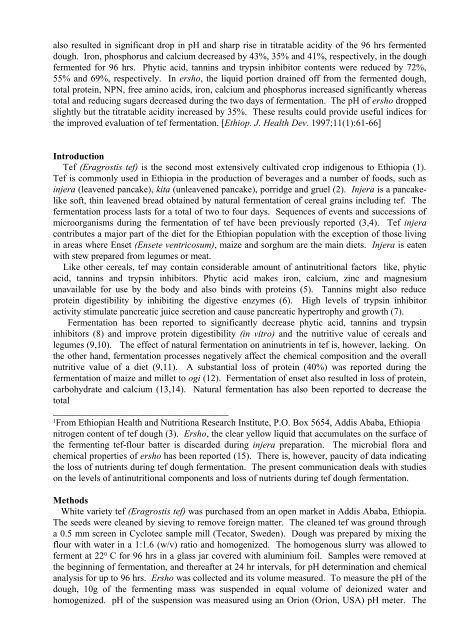Original article - Ethiopian Review
Original article - Ethiopian Review
Original article - Ethiopian Review
- No tags were found...
You also want an ePaper? Increase the reach of your titles
YUMPU automatically turns print PDFs into web optimized ePapers that Google loves.
also resulted in significant drop in pH and sharp rise in titratable acidity of the 96 hrs fermenteddough. Iron, phosphorus and calcium decreased by 43%, 35% and 41%, respectively, in the doughfermented for 96 hrs. Phytic acid, tannins and trypsin inhibitor contents were reduced by 72%,55% and 69%, respectively. In ersho, the liquid portion drained off from the fermented dough,total protein, NPN, free amino acids, iron, calcium and phosphorus increased significantly whereastotal and reducing sugars decreased during the two days of fermentation. The pH of ersho droppedslightly but the titratable acidity increased by 35%. These results could provide useful indices forthe improved evaluation of tef fermentation. [Ethiop. J. Health Dev. 1997;11(1):61-66]IntroductionTef (Eragrostis tef) is the second most extensively cultivated crop indigenous to Ethiopia (1).Tef is commonly used in Ethiopia in the production of beverages and a number of foods, such asinjera (leavened pancake), kita (unleavened pancake), porridge and gruel (2). Injera is a pancakelikesoft, thin leavened bread obtained by natural fermentation of cereal grains including tef. Thefermentation process lasts for a total of two to four days. Sequences of events and successions ofmicroorganisms during the fermentation of tef have been previously reported (3,4). Tef injeracontributes a major part of the diet for the <strong>Ethiopian</strong> population with the exception of those livingin areas where Enset (Ensete ventricosum), maize and sorghum are the main diets. Injera is eatenwith stew prepared from legumes or meat.Like other cereals, tef may contain considerable amount of antinutritional factors like, phyticacid, tannins and trypsin inhibitors. Phytic acid makes iron, calcium, zinc and magnesiumunavailable for use by the body and also binds with proteins (5). Tannins might also reduceprotein digestibility by inhibiting the digestive enzymes (6). High levels of trypsin inhibitoractivity stimulate pancreatic juice secretion and cause pancreatic hypertrophy and growth (7).Fermentation has been reported to significantly decrease phytic acid, tannins and trypsininhibitors (8) and improve protein digestibility (in vitro) and the nutritive value of cereals andlegumes (9,10). The effect of natural fermentation on aninutrients in tef is, however, lacking. Onthe other hand, fermentation processes negatively affect the chemical composition and the overallnutritive value of a diet (9,11). A substantial loss of protein (40%) was reported during thefermentation of maize and millet to ogi (12). Fermentation of enset also resulted in loss of protein,carbohydrate and calcium (13,14). Natural fermentation has also been reported to decrease thetotal_____________________________________1From <strong>Ethiopian</strong> Health and Nutritiona Research Institute, P.O. Box 5654, Addis Ababa, <strong>Ethiopian</strong>itrogen content of tef dough (3). Ersho, the clear yellow liquid that accumulates on the surface ofthe fermenting tef-flour batter is discarded during injera preparation. The microbial flora andchemical properties of ersho has been reported (15). There is, however, paucity of data indicatingthe loss of nutrients during tef dough fermentation. The present communication deals with studieson the levels of antinutritional components and loss of nutrients during tef dough fermentation.MethodsWhite variety tef (Eragrostis tef) was purchased from an open market in Addis Ababa, Ethiopia.The seeds were cleaned by sieving to remove foreign matter. The cleaned tef was ground througha 0.5 mm screen in Cyclotec sample mill (Tecator, Sweden). Dough was prepared by mixing theflour with water in a 1:1.6 (w/v) ratio and homogenized. The homogenous slurry was allowed toferment at 22 0 C for 96 hrs in a glass jar covered with aluminium foil. Samples were removed atthe beginning of fermentation, and thereafter at 24 hr intervals, for pH determination and chemicalanalysis for up to 96 hrs. Ersho was collected and its volume measured. To measure the pH of thedough, 10g of the fermenting mass was suspended in equal volume of deionized water andhomogenized. pH of the suspension was measured using an Orion (Orion, USA) pH meter. The




![to read the full report [pdf, Amharic] - Ethiopian Review](https://img.yumpu.com/52737829/1/190x245/to-read-the-full-report-pdf-amharic-ethiopian-review.jpg?quality=85)











